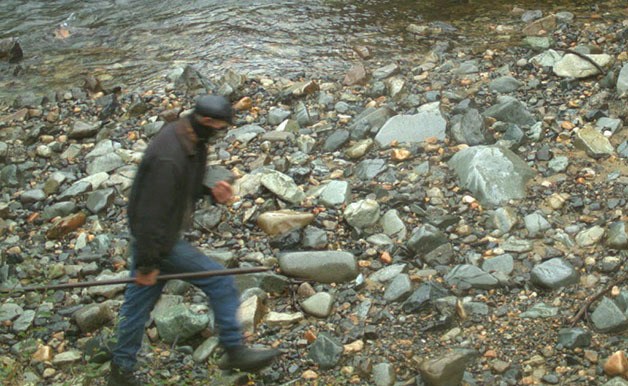The video image shows a masked man hiking along the damp, rocky shore of the South Fork of the Snoqualmie River, carrying a steel bar.
Authorities with Washington State Department of Transportation suspect this is the man who stole nine cameras installed along the I-90 corridor at North Bend, causing an early halt to a wildlife study meant to make highway driving safer.
On Monday, Nov. 10, state workers found half of the agency’s 18 North Bend-area cameras stolen: Four at mile post 29, four at mile post 38, and one at mile post 40. Eleven miles separate the various sites.
“It hurts, and we lost some data,” said Kelly McAllister, a WSDOT wildlife biologist. Luckily, the study was nearing its end: “We’re still going to be able to produce some good results.”
In the works since 2010, WSDOT’s cameras watched and counted animals like elk, deer and bear, and were frequently moved to provide better data and different perspectives.
The likely outcome of the shortened study is a plan for taller, more secure fences on both sides of I-90, so that traveling animals have no choice but to use safer underpasses. The fencing project is currently without funds.
The cameras were kept in steel cases with shielded padlocks, and some were camouflaged to prevent tampering. One of the state’s elk cameras, hidden up a tree, was disguised well enough to escape notice by the apparent thief, and capture his image on camera. The man is tall, with dark or possibly graying hair, wearing a cap and dark bandanna, and dressed in a dark brown jacket, blue jeans, and boots. He was carrying a large metal rod, possibly a pry bar. McAllister said man probably used the bar to pry off a fastener and drop the cameras, inside their steel boxes, to the ground.
The thief either knew exactly where to look, or “he really knows the area well,” McAllister said.
WSDOT is treating the bandanna’ed man in the video as a person of interest.
“We want to talk to him,” said WSDOT public information officer Harmony Weinberg.
According to WSDOT, there are about 16 accidents involving cars hitting elk annually in the North Bend area, based on a five-year average. With elk weighing up to 700 pounds, these crashes can be fatal. That makes understanding the wildlife picture important.
“We’re out to protect drivers, and keep animals in their natural habitat,” Weinberg said. “We want to prevent these collisions.”
Watching wildlife
Before the theft, WSDOT personnel would visit the cameras once a month, swapping memory cards and batteries and sometimes moving them.
During the study, they made some interesting discoveries. At milepost 29, between Snoqualmie and North Bend, two arched culverts are the busiest known bear highway in the state—and possibly anywhere.
“We have documented more bears crossing under there than anybody has documented under a highway anywhere in North America, which is pretty amazing,” McAllister said. He added the caveat that there aren’t that many similar studies in America.
Some of these bears may be visiting local garbage cans—or have done so in the past.
“We’ve had bears with collars and ear tags pass under our cameras,” said McAllister.
Another camera, near North Bend’s milepost 31, showed groups of elk frequently following the river.
“You wouldn’t believe the number of elk that go under the west side of the river.”
The theft cost WSDOT about $7,000, and shuttered the study.
“It’s going to be a while before we go back,” McAllister said.
• To share tips in the camera theft, contact Kelly McAllister, WSDOT wildlife biologist, at (360) 705-7426.

A spike elk gets safely under Interstate 90 near North Bend, in this image taken by one of WSDOT’s safety-study cameras.


